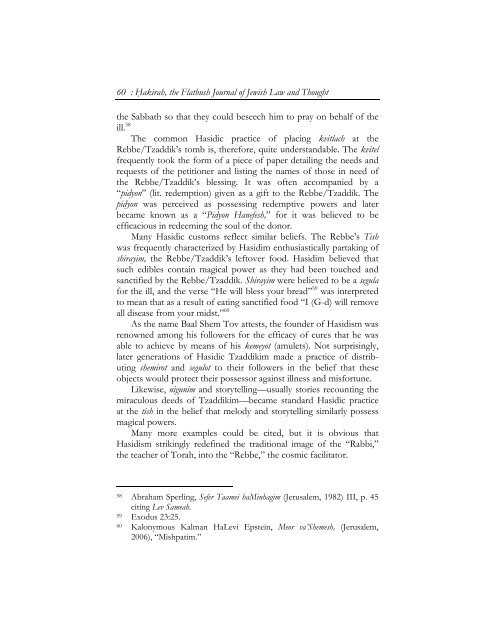Hasidism and the Rebbe/Tzaddik: The Power and Peril of ... - Hakirah
Hasidism and the Rebbe/Tzaddik: The Power and Peril of ... - Hakirah
Hasidism and the Rebbe/Tzaddik: The Power and Peril of ... - Hakirah
You also want an ePaper? Increase the reach of your titles
YUMPU automatically turns print PDFs into web optimized ePapers that Google loves.
60 : Ḥakirah, <strong>the</strong> Flatbush Journal <strong>of</strong> Jewish Law <strong>and</strong> Thought<br />
<strong>the</strong> Sabbath so that <strong>the</strong>y could beseech him to pray on behalf <strong>of</strong> <strong>the</strong><br />
ill. 58<br />
<strong>The</strong> common Hasidic practice <strong>of</strong> placing kvitlach at <strong>the</strong><br />
<strong>Rebbe</strong>/<strong>Tzaddik</strong>’s tomb is, <strong>the</strong>refore, quite underst<strong>and</strong>able. <strong>The</strong> kvitel<br />
frequently took <strong>the</strong> form <strong>of</strong> a piece <strong>of</strong> paper detailing <strong>the</strong> needs <strong>and</strong><br />
requests <strong>of</strong> <strong>the</strong> petitioner <strong>and</strong> listing <strong>the</strong> names <strong>of</strong> those in need <strong>of</strong><br />
<strong>the</strong> <strong>Rebbe</strong>/<strong>Tzaddik</strong>’s blessing. It was <strong>of</strong>ten accompanied by a<br />
“pidyon” (lit. redemption) given as a gift to <strong>the</strong> <strong>Rebbe</strong>/<strong>Tzaddik</strong>. <strong>The</strong><br />
pidyon was perceived as possessing redemptive powers <strong>and</strong> later<br />
became known as a “Pidyon Hanefesh,” for it was believed to be<br />
efficacious in redeeming <strong>the</strong> soul <strong>of</strong> <strong>the</strong> donor.<br />
Many Hasidic customs reflect similar beliefs. <strong>The</strong> <strong>Rebbe</strong>’s Tish<br />
was frequently characterized by Hasidim enthusiastically partaking <strong>of</strong><br />
shirayim, <strong>the</strong> <strong>Rebbe</strong>/<strong>Tzaddik</strong>’s leftover food. Hasidim believed that<br />
such edibles contain magical power as <strong>the</strong>y had been touched <strong>and</strong><br />
sanctified by <strong>the</strong> <strong>Rebbe</strong>/<strong>Tzaddik</strong>. Shirayim were believed to be a segula<br />
for <strong>the</strong> ill, <strong>and</strong> <strong>the</strong> verse “He will bless your bread” 59 was interpreted<br />
to mean that as a result <strong>of</strong> eating sanctified food “I (G-d) will remove<br />
all disease from your midst.” 60<br />
As <strong>the</strong> name Baal Shem Tov attests, <strong>the</strong> founder <strong>of</strong> <strong>Hasidism</strong> was<br />
renowned among his followers for <strong>the</strong> efficacy <strong>of</strong> cures that he was<br />
able to achieve by means <strong>of</strong> his kemeyot (amulets). Not surprisingly,<br />
later generations <strong>of</strong> Hasidic <strong>Tzaddik</strong>im made a practice <strong>of</strong> distributing<br />
shemirot <strong>and</strong> segulot to <strong>the</strong>ir followers in <strong>the</strong> belief that <strong>the</strong>se<br />
objects would protect <strong>the</strong>ir possessor against illness <strong>and</strong> misfortune.<br />
Likewise, nigunim <strong>and</strong> storytelling—usually stories recounting <strong>the</strong><br />
miraculous deeds <strong>of</strong> <strong>Tzaddik</strong>im—became st<strong>and</strong>ard Hasidic practice<br />
at <strong>the</strong> tish in <strong>the</strong> belief that melody <strong>and</strong> storytelling similarly possess<br />
magical powers.<br />
Many more examples could be cited, but it is obvious that<br />
<strong>Hasidism</strong> strikingly redefined <strong>the</strong> traditional image <strong>of</strong> <strong>the</strong> “Rabbi,”<br />
<strong>the</strong> teacher <strong>of</strong> Torah, into <strong>the</strong> “<strong>Rebbe</strong>,” <strong>the</strong> cosmic facilitator.<br />
58 Abraham Sperling, Sefer Taamei haMinhagim (Jerusalem, 1982) III, p. 45<br />
citing Lev Sameah.<br />
59 Exodus 23:25.<br />
60 Kalonymous Kalman HaLevi Epstein, Meor va’Shemesh, (Jerusalem,<br />
2006), “Mishpatim.”

















